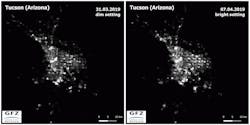The GFZ German Research Centre for Geosciences located at the Helmholtz Centre Potsdam has published research on the impact of LED street lights on sky glow and the dark sky. The International Dark-Sky Association (IDA) was also involved in the project that revealed a lesser than expected impact on the dark sky attributable to LED-based street lights. The tests of connected, outdoor solid-state lighting (SSL) in the city of Tucson, AZ were captured via satellite imagery and analyzed to reveal the surprising conclusions.
The IDA has had a long and occasionally contentious relationship with the SSL industry, with the organization supporting the idea of more directional LED sources while fighting for policy that limits light levels and mandates warmer CCT. We published a very compelling article on these outdoor lighting topics back in 2015. More recently, the IDA has pursued a more conciliatory stance with the SSL industry and indeed is working with the Illuminating Engineering Society (IES) to establish new outdoor lighting guidelines. With the IDA involved in the GFZ work, you have stakeholders from varying perspectives that agree on the results of the recent research.
The team led by Dr. Christopher Kyba from the GFZ chose to study the lighting in Tucson because the city has upgraded most all of its street lights to LED technology, and most of the inventory is wirelessly connected and easily dimmable. The city typically operates the outdoor lighting at 90% of maximum during the busier part of the evening and dims the lights to 60% of maximum at midnight.
The researchers were able to change the intensity settings of 14,000 of the 19,500 street lights in the city. The team brightened the lights to 100% intensity on some evenings and dimmed them to 30% of maximum on other nights (shown dimmed in photo above). Data sets from the specific test nights and from normal operational nights were captured by the US Suomi National Polar-orbiting Partnership (NPP) satellite that is well known for capturing images around the globe of light pollution (see nearby satellite images). The NPP captured data on four test nights and two normal operational nights.
By analyzing the data based on different operational intensity of the street light system, the research team determined that only 20% of the light produced at night in Tucson comes from street lights. The team said lit signs and façades, brightly-lit shop windows, lit sports fields, and other sources are the prime culprits in light pollution. Given the transition to directional LEDs, the results should not come as a total surprise. Most LED street lights, excepting some decorative vintage post-top models, generate no uplight directly. So only reflections from pavement and other surfaces would be visible in a satellite image.
Simultaneously with the satellite data capture, the team including Dr. John Barentine, director of conservation at the IDA, also observed the lighting from the ground and took measurements at ground level of sky brightness. “Taken together, these studies show that in a city with well-designed street lights, most of the light emissions and light pollution come from other lights,” said Barentine. The research team is encouraging municipalities to rethink their policies that attempt to limit light pollution.
The team also asserted that there was no evidence that reducing light levels to 30% impacted safety in the city. Indeed, the city residents didn’t seem to take note of the changes. No complaints were lodged by citizens. And the team noted that the human visual system adapts easily to such changes. The team did not suggest that cities try and conserve even more energy via even lower light levels, but that would seem to be a direction forward. Indeed, much of the guidance from organizations such as the IES on light levels is still influenced by legacy sources where spectral quality made it difficult to see well.
The research was initially revealed in an article published in the academic journal Lighting Research and Technology. The GFZ has since posted the details on its website. That webpage has an image from the NPP satellite that is animated and rotates between different nights as well as an animated image of the street lights at different intensity from ground level.
For up-to-the-minute LED and SSL updates, why not follow us on Twitter? You’ll find curated content and commentary, as well as information on industry events, webcasts, and surveys on our LinkedIn Company Page and our Facebook page.






